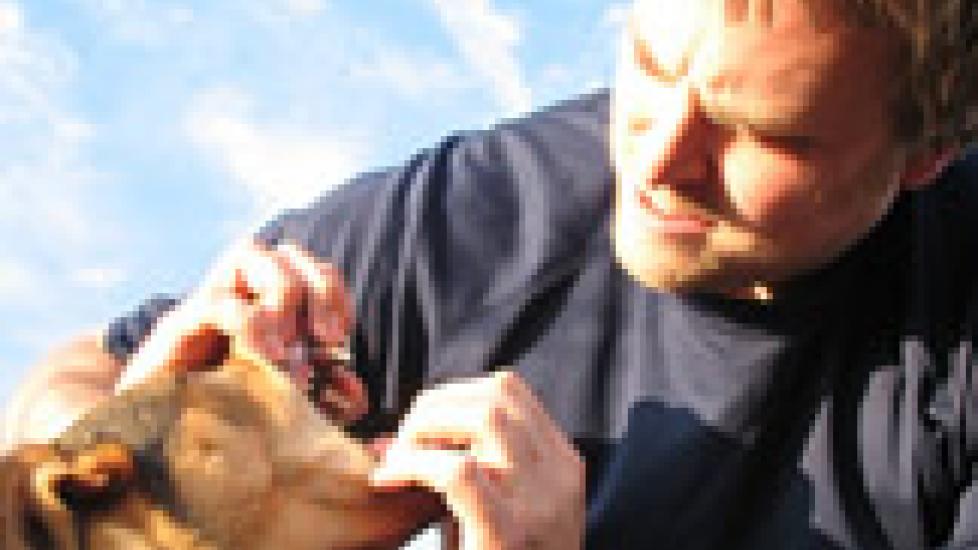The Anatomy of a Physical Exam: A Vet’s Perspective
A client got mad at me the other day because I couldn’t diagnose what was wrong with her dog based on just an exam.
The dog was freshly adopted from the shelter, and their complaint was he slept a lot. Mia, my lab, sleeps the majority of the day, so I’m used to that. It’s normal for her. But was it normal for this dog? We also had no history on this dog, and his physical was normal except that he was skinny.
A mature adult Husky, he actually seemed pretty mellow. These folks had adopted him a day or two ago, so I suggested taking a little time to get to know him. If he didn’t put on any weight, developed any symptoms, or just didn’t seem right, I told them I’d have to run some tests to figure out what was going on because the physical wasn’t telling me anything.
Money was an issue, so they were cool with the plan. Then the dog started to vomit and the irate daily calls started. They demanded to know why I couldn’t figure out what was wrong with the dog. They insisted my exam wasn’t thorough enough.
I assured them I always do a full exam, but would be happy to repeat it if they felt it wasn’t to their liking. I also told them that, most likely, I’d find the same thing -- no abnormal findings except a skinny dog -- and other tests would be needed.
I never saw them again. I decided that maybe I should work a little harder to explain what I’m doing when I do an exam so people feel like they get their money’s worth (granted, this was the first time this had happened to me in 13 years).
So, in case you were wondering, here’s what goes on when I do a full physical exam on a patient (depending on what they’re in for, I may look at some parts more thoroughly than others):
1. I start at the head.
a. Looking at the nose for crusties, color loss, change in texture, etc. b. Checking the teeth, lips, gums (this is usually where you, the client, get the dental lecture). I’m also looking for infection, hair loss, growths, color change, ulcers, etc. c. I might attempt to look at the back of the mouth for growths, ulcers, etc. d. Sometimes I squeeze the head muscles looking for discomfort that may indicate a headache or jaw pain
2. Check the eyes, eye lashes, lids. Look at the pupils for size/symmetry (especially in neurological cases). I look at the back of the eye with my opthalmoscope. Mostly looking for cataracts, and retinal hemorrhages. There is a window during which you have to get a cataract in a dog fixed, if you’re so inclined to do so, so I try to catch those early. I may push back on the closed eyeball, looking for any pain.
3. Check the ears. I visually inspect the pinna (floppy part) for hair loss, scabs, crusts, scratches, scrapes, etc. I look into the ears with my otoscope to check for infection, polyps and such.
4. I look at the overall physical condition of the patient. Too skinny? Too fat? Just right? Any muscle wasting? Pain? Is he alert? Disoriented? Depressed?
5. How’s his coat and skin? Bald? (If so: symmetrical or patchy? Smooth or scaly?) Stinky? Rough? Discolored? Thin? Lumps or bumps? Scrapes or scratches?
6. Any musculoskeletal oddities, especially when the patient has random pain. Are his reflexes okay? Can he feel his feet? Can he feel pain? For neck pain I’ll crank the head all the way up, down, left and right. For back pain I may squeeze all along the spinal cord from side to side and push down from the top.
7. Next I go up to the head again and feel all the lymph nodes. They are under the jaw, in front of the shoulders, armpits, inguinal and behind the knees. A Golden Retriever that comes in with multiple big nodes has lymphoma (cancer of the lymphatics) until proven otherwise.
8. Then my techs know to flip the patient around and let me feel his belly. I’m palpating the abdomen for organ enlargement (spleen, liver, masses). Do they slip around like they should or are they all glommed together from dehydration (a "doughy" abdomen). Does the patient have a super full bladder indicating an obstruction? Does it hurt? In cats, I can feel the kidneys. As a young student I felt like I couldn’t feel anything. They told me to keep at it, do it until you get bored with normal, then when abnormal crops up, you will definitely know it. To this day I can remember my first big spleen, my first bladder stone, cancerous mass. Each discovery was a thrill, after all those boring exams.
It’s important to note that I always do a physical exam the same way. They told me to do this in vet school, when I thought an exam wasn’t as important as the bloodwork, X-rays, fancy tests, etc. I now know a properly executed exam is crucial and can provide piles of information about a case.

Dr. Vivian Cardoso-Carroll
Image: Nate and Zara by Jesse Bikman
